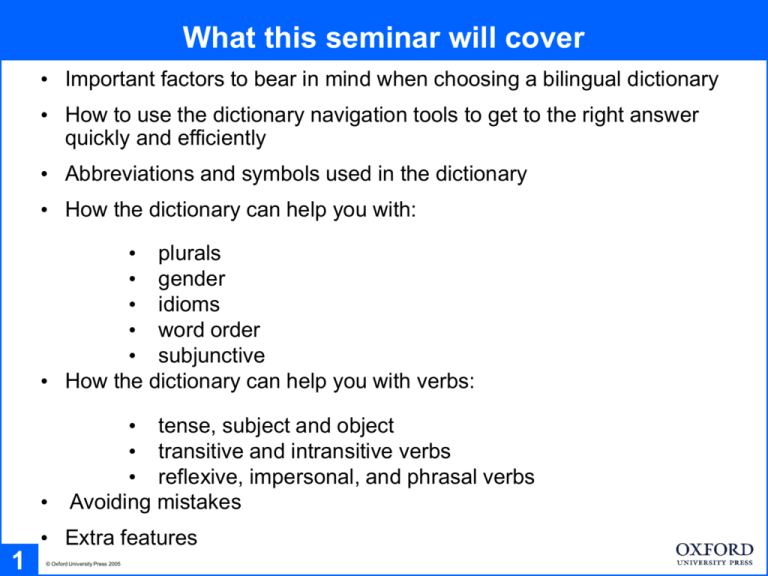Lecture Slides (ppt: 3MB)
advertisement

What this seminar will cover • Important factors to bear in mind when choosing a bilingual dictionary • How to use the dictionary navigation tools to get to the right answer quickly and efficiently • Abbreviations and symbols used in the dictionary • How the dictionary can help you with: • plurals • gender • idioms • word order • subjunctive • How the dictionary can help you with verbs: • • tense, subject and object • transitive and intransitive verbs • reflexive, impersonal, and phrasal verbs Avoiding mistakes • Extra features 1 © Oxford University Press 2005 What any good dictionary should offer • Range of vocabulary • Up-to-date vocabulary • Ease of use • Clarity of design • Clear entry structure • Large number of examples • Pointers towards the right translation • Help with forming sentences in Spanish • Sample letters and CVs, verb tables, and other helpful material • And – only with the Oxford Spanish Dictionary – a free pronunciation CD-ROM that lets you type in any Spanish word, phrase, or sentence and hear it spoken back so you can practise speaking Spanish for presentations or exams 2 © Oxford University Press 2005 What your dictionary can help you with examples using let in the perfect tense? su/sus? register? warning that llamar is followed by a in this context? His dad didn’t let me phone my friend Sarah. finding let = allow quickly? examples showing let + another verb in infinitive? mi/mí/mis? Su padre no me dejó llamar a mi amiga Sarah. 3 © Oxford University Press 2005 Navigating the dictionary • Spanish-English section first, then English-Spanish • blue-edged section in the middle separates the two sides • printed thumb tabs on the outside margin of every page show which letter appears on that page • ‘running heads’ at the top of the page show the first and last words on that page NB: All this applies to the Oxford Spanish Dictionary. Other dictionaries may have different conventions. 4 © Oxford University Press 2005 The sequence of grammatical categories English – Spanish Start Programs • Noun Either: • Adjective • Adjective • Adverb • Adverb • Verb • Noun • Idioms in bold italics within entry Microsoft Word Spanish – English Or: • Transitive verb • Intransitive verb • Phrasal verbs (e.g. pull in, drop off) • Reflexive verb • Impersonal verb Then: Document NB: All this applies to the Oxford Spanish Dictionary. Other dictionaries may have different conventions. 5 © Oxford University Press 2005 • Idioms in bold italics within entry • Compounds Navigating an English-Spanish entry (I) headword phonetic symbols noun translation subdivisions of senses swung dash represents headword idioms in bold italics within entry contextualizations in angled brackets single brackets = object double brackets = subject verbs with spelling irregularities marked with asterisk main senses phrasal verbs at end signposts to meaning in parentheses labels to indicate register 6 © Oxford University Press 2005 © Oxford Spanish Dictionary 3rd edition 0-19-860475-0 Navigating an English-Spanish entry (II) a kind offer kind: noun or adjective? narrow the meaning by using context una amable oferta 7 © Oxford University Press 2005 La miró comprensivo © Oxford Spanish Dictionary 3rd edition 0-19-860475-0 Navigating a Spanish - English entry nouns are listed with their gender links to verb tables at back of dictionary warnings of translation traps 8 © Oxford University Press 2005 © Oxford Spanish Dictionary 3rd edition 0-19-860475-0 Common Grammatical Categories 9 adj adjective describes a noun or pronoun sad, triste adv adverb tells you how sth is done comfortably, cómodamente art article definite article = the indefinite article = a a, the, una, el, la, los v aux auxiliary verb used with main verb to show tense (have, haber etc.) she has arrived ha llegado conj conjunction links two phrases because, porque n noun thing, person or idea life, vida prep preposition used with noun to show position near, cerca da pron pronoun stands instead of a noun he, el vi intransitive verb verb without an object I have drunk he bebido vt transitive verb verb used with a direct object I have drunk the water he bebido el agua v pron reflexive verb verb requiring a reflexive pronoun to wash oneself, lavarse © Oxford University Press 2005 Common Grammatical Categories Match these words with the correct part of speech 10 cangrejo v pron azulado prep perfectamente nm inscrito pp cenizas conj lavarse adj o adv sobre fpl © Oxford University Press 2005 Hyphen – and Swung Dash (or Tilde) ~ The hyphen indicates the feminine ending replaces the masculine one: The swung dash stands for the whole headword so the ending is added: Subject Field Labels Zool = Zoology Equ = Equitación • Check the list of subject field labels in the abbreviations list inside the front cover of the dictionary to see whether it covers areas you are interested in 11 © Oxford University Press 2005 © Oxford Spanish Dictionary 3rd edition 0-19-860475-0 Regional Usage A selection of regional usage abbreviations: AmE = American English AmC = Central American Spanish Austral = Australian English AmL = Latin American Spanish BrE = British English AmS = South American Spanish IrE = Irish English Andes = Andes Spanish Scot = Scottish English Arg = Argentinian Spanish Register colloq* colloquial fam** familiar hum humorous pej* pejorative pey** pejorative vulg vulgar *used with English words **used with Spanish words pejorative (in Spanish: peyorativo) = a word that expresses contempt or disapproval e.g. 12 © Oxford University Press 2005 © Oxford Spanish Dictionary 3rd edition 0-19-860475-0 Sentence patterns shows pattern: sb (somebody) algn (alguien) sth (something) algo (algo) absolver a algn DE algo to absolve sb OF sth verb + a + person + DE + thing a algn shows you must use a with a person object Yo te absuelvo de tus pecados I absolve you of your sins 13 © Oxford University Press 2005 © Oxford Spanish Dictionary 3rd edition 0-19-860475-0 Phonetics 14 © Oxford University Press 2005 © Oxford Spanish Dictionary 3rd edition 0-19-860475-0 Irregular Plurals taboo taboos = tabúes or tabús 15 © Oxford University Press 2005 © Oxford Spanish Dictionary 3rd edition 0-19-860475-0 Gender 1 2 4 3 8 5 6 7 16 © Oxford University Press 2005 © Oxford Spanish Dictionary 3rd edition 0-19-860475-0 Idioms Idiom = a saying whose meaning has evolved so that it is now different from the original literal meaning of the key words within it. It was a difficult decision for Carol, and it was a long time before she could bring herself to grasp the nettle. Si no estuviera lesionado, otro gallo cantaría. 17 © Oxford University Press 2005 © Oxford Spanish Dictionary 3rd edition 0-19-860475-0 Word Order shows construction where word order changes: 18 © Oxford University Press 2005 © Oxford Spanish Dictionary 3rd edition 0-19-860475-0 Expressions requiring the subjunctive warning note: shows when subjunctive is required: 19 © Oxford University Press 2005 © Oxford Spanish Dictionary 3rd edition 0-19-860475-0 Verb Basics Types of verbs: • Transitive and Intransitive • Reflexive • Impersonal • English phrasal verbs Other help with verbs: • Verb tables • Verb complementation 20 © Oxford University Press 2005 Quick refresher on grammatical verb terms (I) • Tense = present, future, past, conditional, imperfect etc. • Subject = the noun or pronoun that causes the action of the verb – The dog ate the meat = El perro comió la carne – Dolores loves Paco = Dolores quiere a Paco • Object = the word or group of words which is affected by the action indicated by the verb – The dog ate the meat = El perro comió la carne – Dolores loves Paco = Dolores quiere a Paco 21 © Oxford University Press 2005 Quick refresher on grammatical verb terms (II) • Objects can be further divided into direct and indirect objects: • Direct object = the noun or pronoun directly affected by the verb - Dolores quiere a Paco = Dolores loves Paco - Dolores lo quiere = Dolores loves him (also le in Spain) - El perro comió la carne = The dog ate the meat - El perro la comió = The dog ate it • Indirect object = the noun or pronoun indirectly affected by the verb. In English, indirect objects are usually preceded by a preposition (from, to, at, etc.) - Dolores sueña con Paco = Dolores is dreaming about Paco - Dolores sueña con él = Dolores is dreaming about him - Paco habla con Dolores = Paco speaks to Dolores - Paco habla con ella = Paco speaks to her 22 © Oxford University Press 2005 Transitive and Intransitive Verbs (I) • Transitive verbs = vt (verbo transitivo) = verbs used with direct object • I wrote the letter = (Yo) escribí la carta • Dolores loves Paco and María = Dolores quiere a Paco y María • She loves them = (Ella) los quiere • Intransitive verbs = vi (verbo intransitivo) = verbs that do not have an object • The sun is shining = Brilla el sol • She ran very fast = (Ella) corrió muy rápidamente • Paco and María left yesterday = Paco y María se marcharon ayer • Transitive verbs do something to the object that follows them. • Intransitive verbs stand on their own without an object following them. 23 © Oxford University Press 2005 Transitive and Intransitive Verbs (II) • • • • • • The same verb can be used both transitively and intransitively: sacar Sacaron el reportaje They published the report = transitive use (el reportaje = direct object) Te toca a ti sacar It’s your turn to serve = intransitive use (no object) • entrar • Voy a entrar el coche • I’m just going to put the car away = transitive use (el coche = direct object) • En ese moment entró Nicolás • Just then Nicolás came in = intransitive use (no object) • scatter • Scatter some cushions around on the floor = transitive use (some cushions = direct object) • The birds scattered = intransitive use (no object) 24 © Oxford University Press 2005 © Oxford Spanish Dictionary 3rd edition 0-19-860475-0 Transitive and Intransitive Verbs Exercise esparcir: Él esparció la arena. transitive (vt) and intransitive (vi) dispersarse: La muchadumbre se dispersó. 25 © Oxford University Press 2005 © Oxford Spanish Dictionary 3rd edition 0-19-860475-0 Reflexive Verbs (I) English-Spanish: v refl = reflexive verb Spanish-English: v pron = verbo pronominal • Reflexive verbs are verbs whose subject is the same as their object. They describe what you do to yourself. • Reflexive verbs are used with an extra pronoun, called a ‘reflexive pronoun’: myself, yourself, yourselves, themselves, etc / me, te, se etc • Me levanto = I get up • Luego me lavo y me cepillo los dientes = Then I wash myself and brush my teeth (literally = brush to myself the teeth ) The same verb can be used reflexively and not reflexively: • Abrió la puerta = she opened the door • La puerta se abrió = the door opened 26 © Oxford University Press 2005 Reflexive Verbs (II) 1st pers singular yo me no me apetece ir I don't feel like going 2nd pers singular tu usted te se tú no te atreverías you wouldn’t dare 3rd pers singular él/ella se el ambiente en que ella se mueve me es totalmente ajeno the world she moves in is quite alien o foreign to me 1st pers plural nosotros nos nos estrellamos contra un árbol we crashed into a tree 2nd pers plural vosotros ustedes os se os veréis mañana you’ll see each other tomorrow 3rd pers plural ellos/ ellas se el pánico se adueñó de ellos they were overcome with panic • Remember: just because a verb is reflexive in the source language, it doesn’t mean it’s reflexive in the target language. None of the examples in this table is translated by a reflexive verb in English. 27 © Oxford University Press 2005 © Oxford Spanish Dictionary 3rd edition 0-19-860475-0 Impersonal Verbs • Impersonal verbs = v impers throughout the dictionary • Impersonal verbs use it in English and the third person in Spanish: Llueve = It’s raining • Ser and estar are used with nouns and adjectives to form impersonal expressions: Es preciso que estés listo = You must be ready Está visto que no le interesa = It’s obvious that he’s not interested English Phrasal Verbs • Phrasal verbs are at the end of the entry, marked • verb + preposition or adverb e.g. run away • Other examples: give up, take off, let down • There are no phrasal verbs in Spanish 28 © Oxford University Press 2005 Phrasal verbs Verb Tables Verbs are listed at their infinitive form: we went to Italy they bought a DVD quisieron marcharse puse la mesa me he equivocado tuvo que detenerse look up the infinitive go look up the infinitive buy look up the infinitive querer look up the infinitive poner look up the infinitive equivocar look up the infinitive tener El Atlético defeated Nantes check against verb table A1 at the back derrotaron El Atlético derrotó al Nantes 29 © Oxford University Press 2005 © Oxford Spanish Dictionary 3rd edition 0-19-860475-0 Verb Complementation (I) = the range of structures that can be used after any given verb to forgive sb FOR sth = perdonarle algo A algn She forgave him for what he’d done Le perdonó lo que había hecho querer QUE algn/algo + SUBJ = to want sb/sth TO + INF Quiere que se vaya She wants him to leave 30 © Oxford University Press 2005 © Oxford Spanish Dictionary 3rd edition 0-19-860475-0 Verb Complementation (II) • There are many different patterns of verb complementation in Spanish and these are shown in the dictionary entry. • Think of the difference between: - pensar en algo/algn = to think about sth/sb - pensar + INF = to think of -ING - dejar de + INF = to stop -ING - dejar algo/a algn + INF = to let sth/sb + inf - dejar que algo/algn + SUBJ = to let sth/sb + inf 31 © Oxford University Press 2005 Adapting Examples Careful! Sometimes you may need to adapt a given translation: Nouns: • may have plurals which entail changes to their accentuation The change is not given if regular. • may require modifications to demonstrative or possessive adjectives (e.g. mi, mis) • feminine nouns may require accompanying adjectives to add -a, or -as (if plural) • if you refer to feminine nouns in a preceding sentence, the pronoun will be ella/ellas or la/las Verbs: • need to be in the correct form (number, tense, indicative or subjunctive) • need the appropriate reflexive pronoun, if they are pronominal (reflexive) (e.g. nos burlamos de él) • need to use the right structures (e.g. distraer a algn de algo) 32 © Oxford University Press 2005 Cross-checking Cross-checking in the other side of the dictionary helps when: • a Spanish word has several meanings • you are unsure which Spanish translation to choose • you don’t know if the Spanish word you know can be used in a certain context • you want to check the plural or feminine form • you want to know how to conjugate the verb • you want to look at more examples that use the Spanish word 33 © Oxford University Press 2005 What else can a good dictionary offer you? 1 Information about life and culture 2 Thematic boxes explaining grammatical points and giving extra vocabulary, crossreferenced from the headword … 3 Correspondence – letters, CVs, emails This is the standard formula for starting a business letter addressed to archivos a firm or adjuntos Ver organization, and not tocarta.jpg) a (carta.pdf, particularEstimado person. Señor Fernández: Aquí le envío, como archivo adjunto, la versión final del diseño 34 © Oxford University Press 2005 4 Spanish verb tables 5 Free pronunciation CD-ROM to help you practise your spoken Spanish © Oxford Spanish Dictionary 3rd edition 0-19-860475-0 Review (I) • Important factors to bear in mind when choosing a bilingual dictionary • Navigating through an entry – English-Spanish, then Spanish-English • Explaining abbreviations and symbols: • hyphen and swung dash (or tilde) • common grammatical categories • subject field labels • regional labels • register labels • sentence patterns • phonetics • How the dictionary can help you with: • plurals • gender • idioms • word order • subjunctive 35 © Oxford University Press 2005 Review (II) • How the dictionary can help you with verbs: • • • • • • tense, subject, and object direct and indirect objects transitive, intransitive, and reflexive verbs impersonal and phrasal verbs verb tables verb complementation • Avoiding mistakes: • adapting examples • cross-checking • Extra features Questions A chance to discuss any ideas or points raised in the seminar 36 © Oxford University Press 2005





